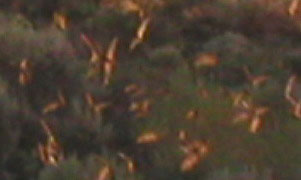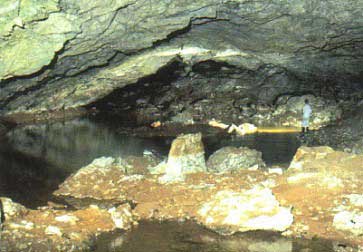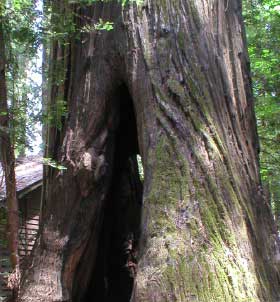
Free-tailed bats out-flying a cave in California.
Click image to enlarge

The Lava Tube Cave in California
 Listen to the Brazilian Free-tailed bats-
Listen to the Brazilian Free-tailed bats- thousands, as they out-fly their cave,
recorded from a frequency division bat detector.
 Free-tailed bats out-flying a cave in California. Click image to enlarge  The Lava Tube Cave in California  Listen to the Brazilian Free-tailed bats-
Listen to the Brazilian Free-tailed bats- thousands, as they out-fly their cave, recorded from a frequency division bat detector. |
Bats are everywhere in the world except the Arctic and Antarctica. There are almost 1,000 species. Of these, 45 species live in the US and Canada.
The Little Brown Bat, Big Brown Bat, Silver-haired Bat and Hoary Bat are widespread across the US and southern Canada. The Pallid Bat, Spotted Bat, Western Small-footed Bat, Western Long-eared Bat, Fringed Bat, Long-legged Bat, Yuma Bat, Brazilian Free-tailed Bat, Western pipistrelle Bat and Townsend's Big-eared Bat can be found in the West.
Some eastern bats are: Eastern Red Bat, Rafinesque's Big-eared Bat, Eastern Pipistrelle Bat, Evening Bat, Indiana Bat and Northern Long-eared Bat.
The Northern Long-eared Bat can be found as far north as the Northwest Territory in Canada. Mastiff Bats are in the South from southern California to the Florida Keys.
The Townsend's Big-eared Bat (Corynorhinus townsendii) was found in a colony at Point Reyes National Seashore, north of San Francisco, in 1987. This is an uncommon bat. The population has grown from 75 to 200 through the protection efforts of the NS and USGS.
A colony of the rarely seen Indiana Bat lives in old limestone caves in Canoe Creek State Park in Pennsylvania. As many as 80,000 bats can hibernate in a cave for the winter. Estimates are that less than 500,000 Indiana Bats still exist.
Most bat speies in The US and Canada are insect eaters, or insectivors. They feed on moths, flying beetles, midges, and caddis flies. A Little Brown Bat can eat as many as 4,000 mosquitoes in a night. However, bats in some other places feed on fruit, nectar, fish, the blood of birds or cattle or even other small mammals. The Jamaican Fruit-eating Bat will eat mangoes, bananas and avocados as well as pollen, nectar and some insects. The Large Slit-faced Bat in Zimbabwe will catch and eat fish and frogs as well as large insects, even other bats. The Hairey-legged Vampire Bat and the Common Vampire Bat can be found in Central and South America. These bats have sharp upper incisor teeth that are used to make the wounds for feeding. Chemicals in the Vampire Bat's saliva promote bleeding in its prey.
 Hayes Cave - NS Museum of Natural History |
In the Province of Nova Scotia, Canada there are six species of bat. The Little Brown Bat being the most common resides here all year. Keen's Bat and Eastern Pipistrille are also full time residents. There are some 300,000 bats in Nova Scotia. Others; Silver-haired bat, Horay and Northern Long-eared bats migrate to warmer climate for the winter. A few Big Brown bats have also been observed. During the winter, bats hibernate in caves or abandoned mines. Their summer roost may be in barns, old sheds or an attic, or in trees - any place that is undisturbed.
Hayes Cave in Hants County, Nova Scotia, is well suited for bat habitat. It was formed over long periods of time by the erosional effect of water flowing through gypsum soil. Here up to 8,000 bats have been observed roosting for their winter hibernation. The cave presents a habitat that is balanced in temperature, humidity, darkness and is undisturbed - all necessary to the bat's survival.
 The Bat Tree - Richardson Grove, CA |
This hollow, giant redwood is summer home for a colony of Yuma bats (Myotis yumanensis). Here lives a colony of females with their babies. The Yuma bats mate in the fall but the female is not pregnant until the spring - the sperm is stored in her body through the winter months. She will have one pup in May, June or July. If disturbed, the mothers are likely to abandon the roost. The solitary males are not seen near the maternity colony. These bats are efficient feeders, typically feeding over water and eating their fill of insects in the first half hour of evening flight. This tree maternity roost is located in Richardson Grove Redwood State Park on the north coast of California, along the So. Fork of the Eel River.
Home Page .... Bats of Williams .... ![]()
Thanks for your visit. If you have any comments or questions, please e-mail: lajones@wolfdenpress.net